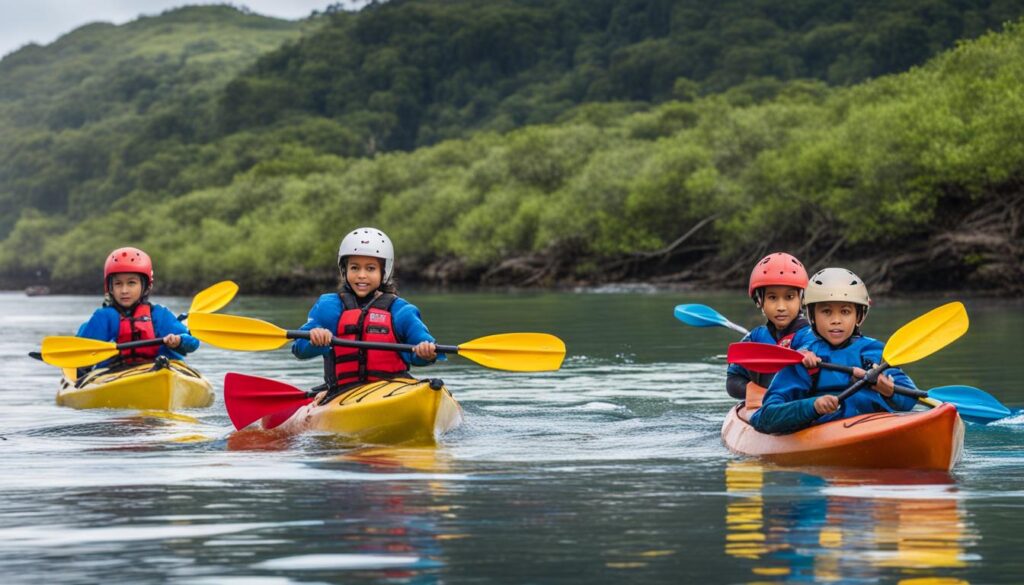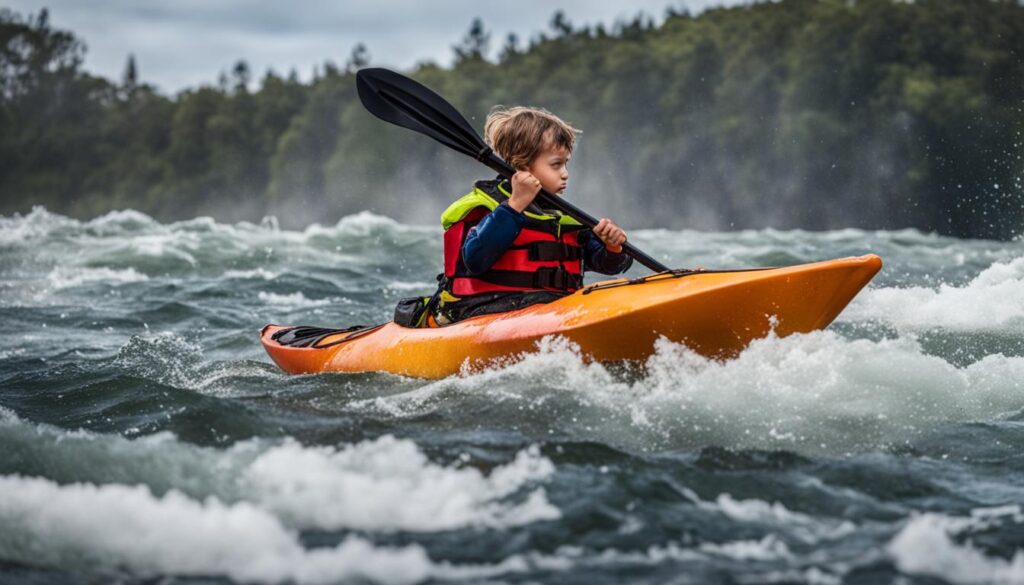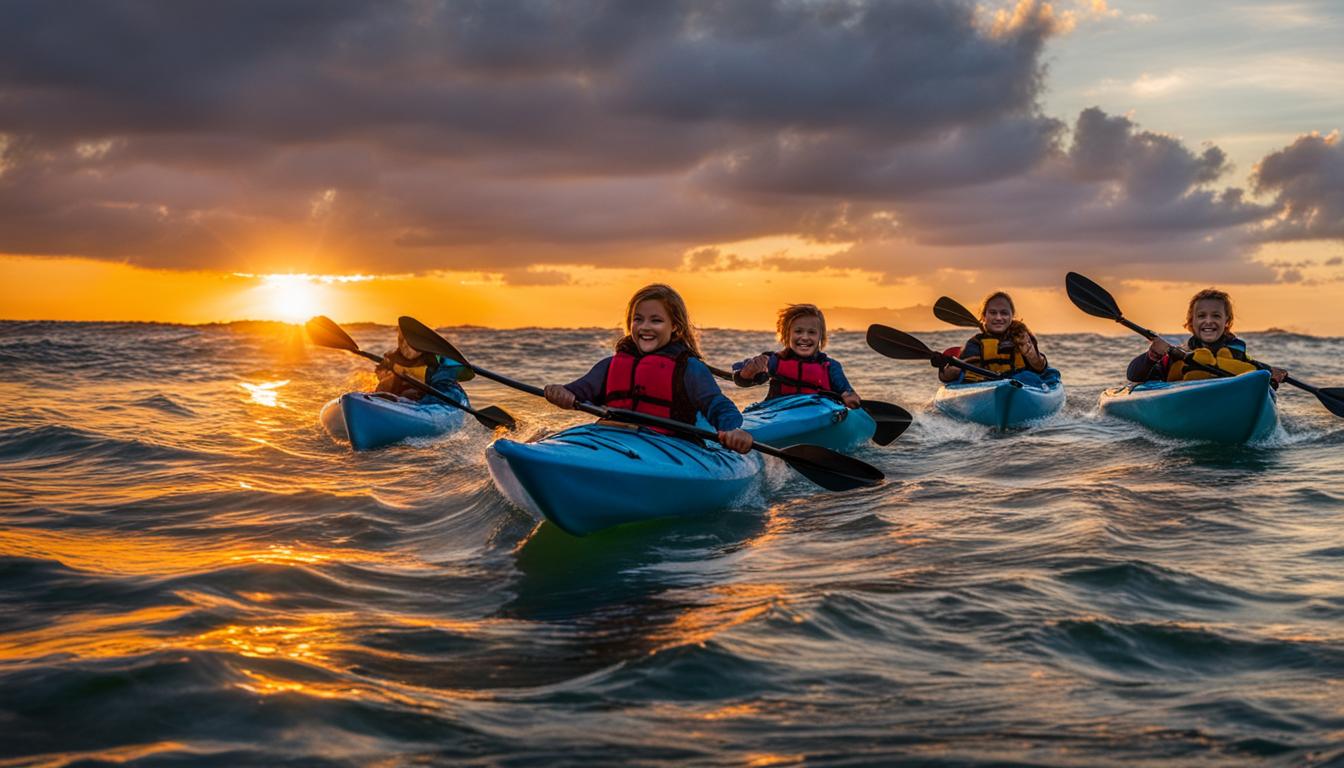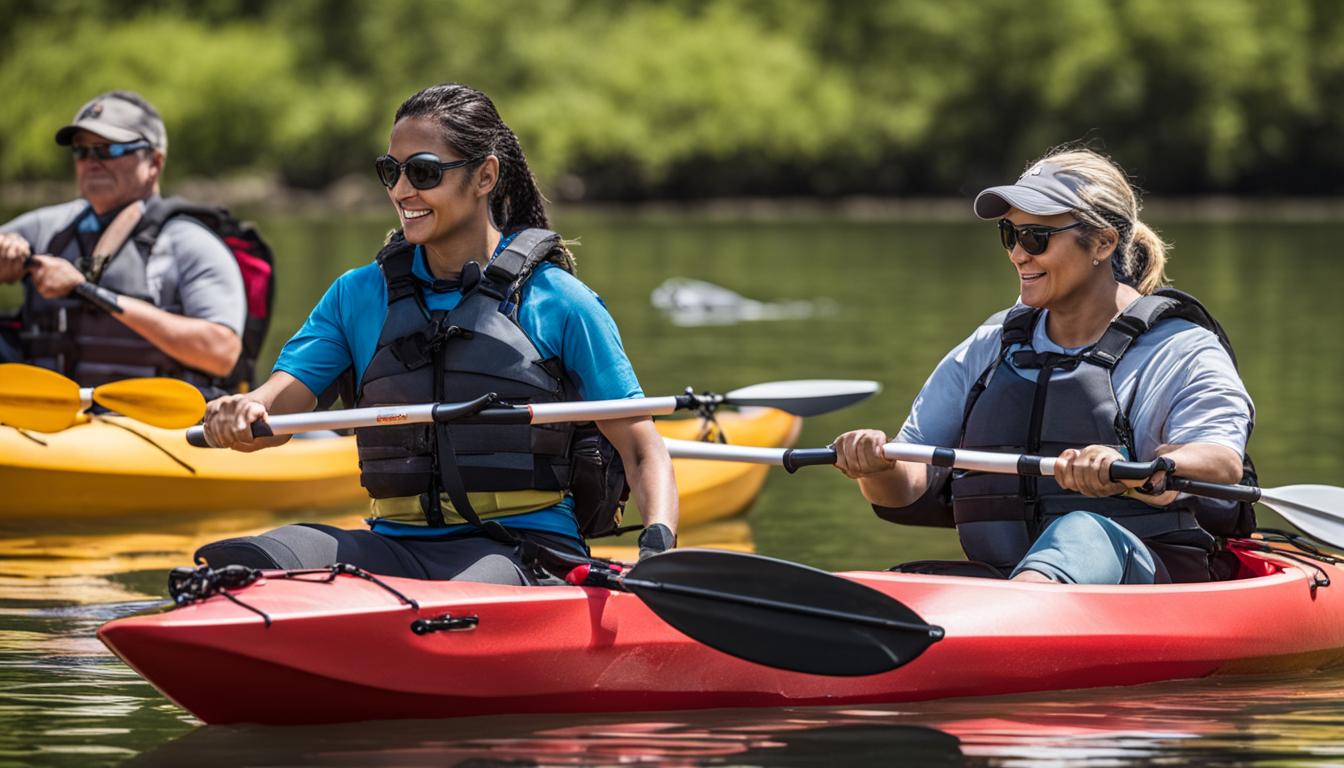When taking children kayaking, it’s important to prepare them for various water conditions to ensure their safety. Teaching kids how to handle different weather and water conditions will equip them with the skills they need for a fun and safe kayaking experience. In this section, we will explore the steps parents can take to prepare their children for kayaking in different conditions, as well as provide safety tips for kids in changing waters.
Key Takeaways:
- Preparing children for kayaking in different water conditions is crucial for their safety and enjoyment.
- Teach kids how to handle different weather patterns and navigate through changing waters.
- Assess children’s skill level and provide them with appropriate gear, including personal flotation devices (PFDs).
- Choose the right water conditions for practice, starting with calm waters before venturing into more challenging conditions.
- Discuss safety measures and emergency preparedness with children to ensure they can respond effectively in unexpected situations.
Assessing Skill Level and Providing Proper Gear
Before taking children kayaking, it’s important to assess their skill level and provide them with the necessary gear. This ensures their safety and enhances their overall kayaking experience. Here are some key considerations when preparing children for kayaking in diverse water environments:
Evaluating Skill Level:
Begin by assessing the child’s swimming ability and comfort in the water. For beginners or young children who can’t swim confidently, ensure they have a properly fitting personal flotation device (PFD) to keep them safe. It’s also important to gauge their overall physical strength and coordination, as kayaking requires a certain level of fitness and motor skills.
Proper Gear:
Provide children with suitable gear based on their age and skill level. For younger kids, consider starting with a tandem kayak, where they can paddle with an adult in a shared kayak. This allows them to gain confidence and learn from an experienced kayaker. Alternatively, older children can paddle in the main compartment of your kayak under close supervision. Additionally, investing in kayaking lessons or training sessions can help children practice the basics and gain confidence in handling the kayak.
Adapting Kayaking Techniques:
Teach children how to adapt their kayaking techniques based on the weather conditions and water environment. For example, they should learn how to paddle against currents, navigate through waves, and maintain stability in rough waters. By introducing these skills gradually, children will develop the necessary adaptability and preparedness for kayaking in diverse conditions.
Remember, safety should always be a priority when kayaking with children. Assess their skill level, provide suitable gear, and teach them the necessary techniques to handle diverse water environments. By taking these precautions, you can ensure that your child has a safe and enjoyable kayaking experience.

Kayaking with Kids: Choosing the Right Water Conditions for Practice
When preparing children for kayaking, it’s important to choose the right water conditions for practice. Starting with calm waters and minimal strong currents allows kids to get comfortable and develop their skills before venturing into more challenging conditions. Whether it’s a formal lesson or a practice trip, providing children with time in calm waters will help build their confidence and prevent burnout.
Additionally, teaching kids about reading water conditions and understanding the potential risks and challenges associated with different weather patterns is crucial. By gradually introducing them to different water conditions, children will be better prepared to handle rough waters and make informed decisions while kayaking.
“The best way to learn how to kayak is to start in calm waters. This will allow your child to focus on the basics and build their confidence gradually. As they become more comfortable, you can gradually introduce them to rougher waters and more challenging conditions.”
Choosing the Right Water Conditions: A Comparison
| Water Conditions | Benefits | Considerations |
|---|---|---|
| Calm Waters |
|
|
| Rough Waters |
|
|
By providing children with exposure to both calm and rough waters, parents can help them develop a well-rounded skill set and the confidence to handle various water conditions. Gradually progressing from one level to another will ensure a safe and enjoyable kayaking experience for kids of all ages.
Essential Safety Measures and Emergency Preparedness
When kayaking with children, it’s crucial to prioritize their safety and be prepared for any potential emergencies. By following these essential safety measures and teaching kids how to respond in unexpected situations, you can ensure a safe and enjoyable kayaking experience for everyone.
Proper Gear and Safety Equipment
Before setting out on the water, it’s important to ensure that both you and your child are wearing the proper gear. This includes personal flotation devices (PFDs) that fit well and are appropriate for the child’s size and weight. Make sure the PFD is securely fastened and that your child knows how to properly wear and adjust it.
In addition to PFDs, it’s a good idea to have other safety equipment on board, such as a whistle or signaling device, a first aid kit, and a tow rope in case you need to assist a tired child. These items can come in handy in emergency situations or when unexpected challenges arise.
Communication and Emergency Preparedness
It’s important to establish clear communication with your child while kayaking. Teach them basic hand signals or verbal cues to ensure that you can effectively communicate important information, such as changes in direction or the need to stop.
Moreover, preparing children for emergency situations is crucial. Discuss the signs of overexertion and fatigue, and make sure they understand the importance of pacing themselves and taking breaks when needed. Teach them how to identify potential hazards in the water and how to react in case of capsizing or being separated from the kayak. Practicing these emergency procedures in a controlled setting can help build confidence and ensure a swift response when faced with unexpected situations.
Weather Conditions and Awareness
Stay informed about the weather conditions before heading out on a kayaking trip with your child. Check the forecast and be mindful of any changes that may occur during your time on the water. Avoid kayaking in adverse weather conditions such as strong winds, thunderstorms, or heavy rain. Teach your child to recognize signs of changing weather and the potential risks associated with them.
Additionally, it’s essential to regularly assess the water conditions during your trip. Keep an eye out for any changes in currents, tides, or waves. If you notice any signs of unsafe conditions, such as rough waters or strong currents, it’s best to move to a safer area or return to shore.

| Safety Tips for Kids in Changing Waters |
|---|
| Always wear a properly fitting personal flotation device (PFD). |
| Communicate clearly with your child using hand signals or verbal cues. |
| Teach your child to recognize signs of fatigue and overexertion. |
| Practice emergency procedures, such as capsizing or being separated from the kayak. |
| Stay informed about weather conditions and avoid kayaking in adverse weather. |
| Regularly assess water conditions and be aware of any changes. |
Conclusion
Preparing children for various water conditions in kayaking is essential for their safety and enjoyment. By assessing their skill level and providing appropriate gear, parents can ensure that young kayakers are ready to face different challenges. Choosing the right water conditions for practice and gradually introducing children to diverse environments will help build their confidence and skills over time.
Teaching kids adaptability in different weather conditions and instilling safety measures and emergency preparedness are crucial aspects of their preparation. By discussing the signs of overexertion and educating children on how to respond in unexpected situations, parents can help keep them safe while kayaking. Packing high-protein snacks and water and keeping outings under an hour are additional safety measures to prevent burnout and ensure hydration.
With proper preparation and guidance, children can become well-equipped to handle rough waters and enjoy a positive and rewarding kayaking experience. By instilling a sense of confidence and teaching them how to navigate through various water conditions, parents can prepare young kayakers for the challenges that lie ahead. So, get ready to hit the water with your little ones and create unforgettable memories!
FAQ
How can I prepare my child for kayaking in different water conditions?
To prepare your child for kayaking in different water conditions, assess their skill level and provide them with the necessary gear, such as a properly fitting personal flotation device (PFD). Consider starting with calm waters and minimal strong currents to build their confidence. It’s also important to teach them about reading water conditions and understanding the potential risks and challenges associated with different weather patterns.
What gear should my child have for kayaking?
For beginners or young children who can’t swim, ensure they have a properly fitting personal flotation device (PFD). Depending on their age and skill level, consider starting with a tandem kayak or having them paddle in the main compartment of your kayak. Additionally, investing in kayaking lessons or training sessions can help children practice the basics and gain confidence in handling the kayak.
How do I choose the right water conditions for my child’s kayaking practice?
Start with calm waters and minimal strong currents to allow your child to get comfortable and develop their skills before venturing into more challenging conditions. Gradually introduce them to different water conditions to help them handle rough waters and make informed decisions while kayaking. It’s important to provide them with time in calm waters to build their confidence and prevent burnout.
What safety measures should I take when kayaking with children?
Safety should always be a priority when kayaking with children. In addition to wearing proper gear such as personal flotation devices (PFDs), plan for emergencies and educate children on how to respond in unexpected situations. Teach them to recognize signs of overexertion and avoid fatigue while kayaking. Keep outings under an hour, pack high-protein snacks, and stay hydrated to prevent burnout.
How can I ensure my child is prepared for kayaking in rough waters?
Assess your child’s skill level, provide appropriate gear, and choose the right water conditions for practice to ensure they are prepared for kayaking in rough waters. Teach them adaptability in different weather conditions and instill safety measures and emergency preparedness. By gradually introducing them to different water conditions, they will be better equipped to handle challenging situations during kayaking.





